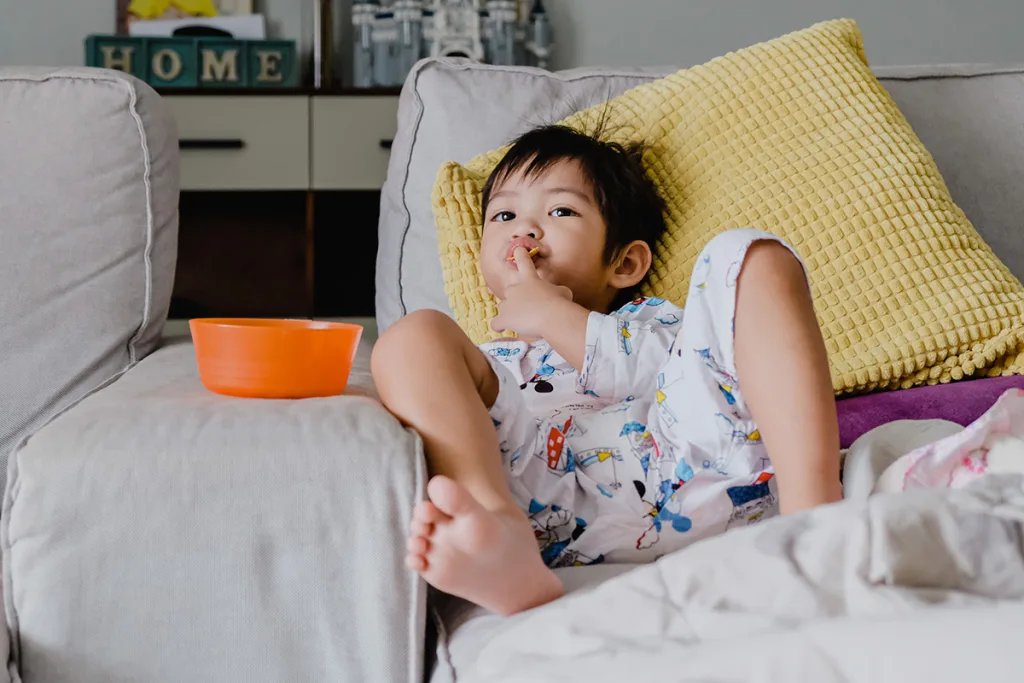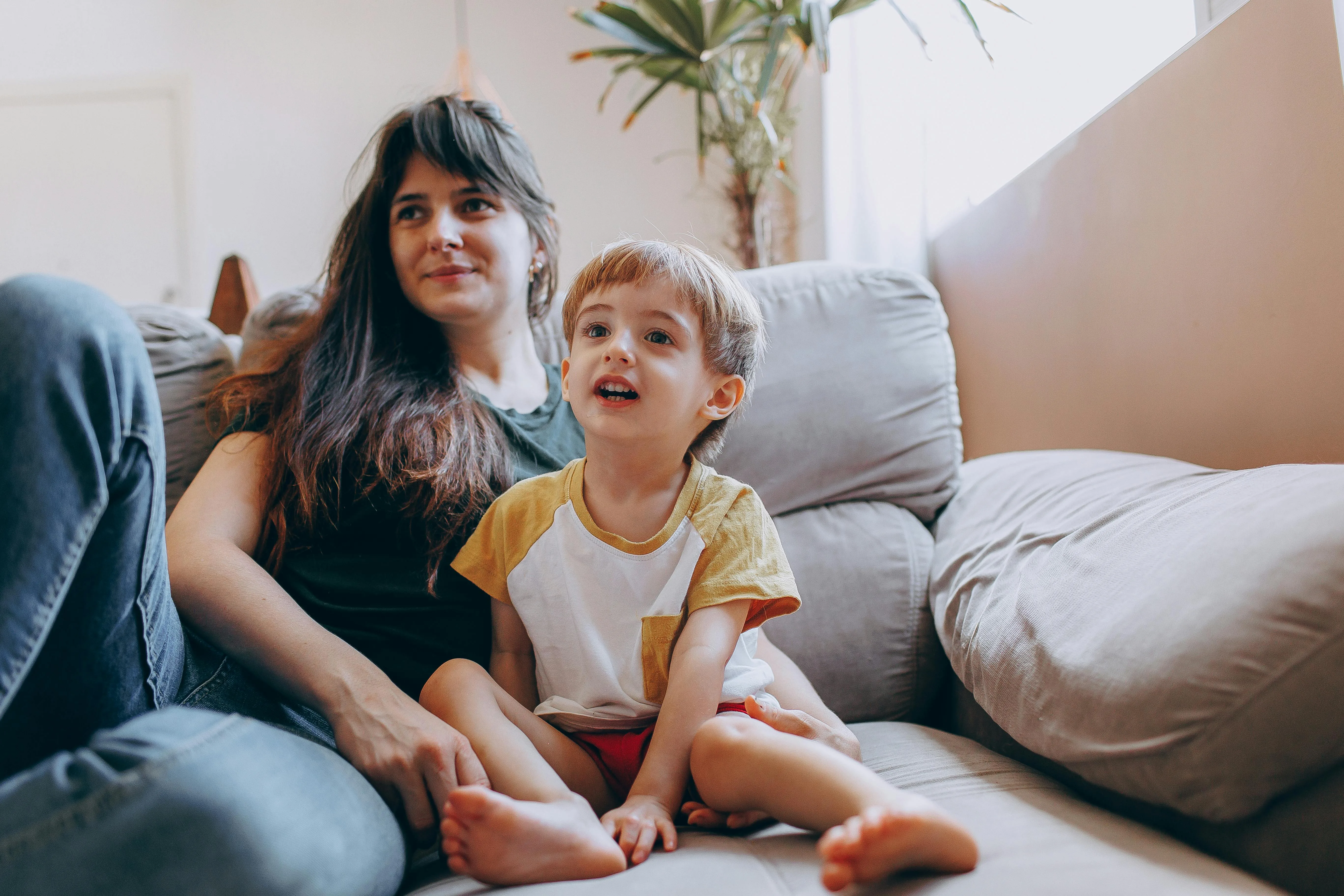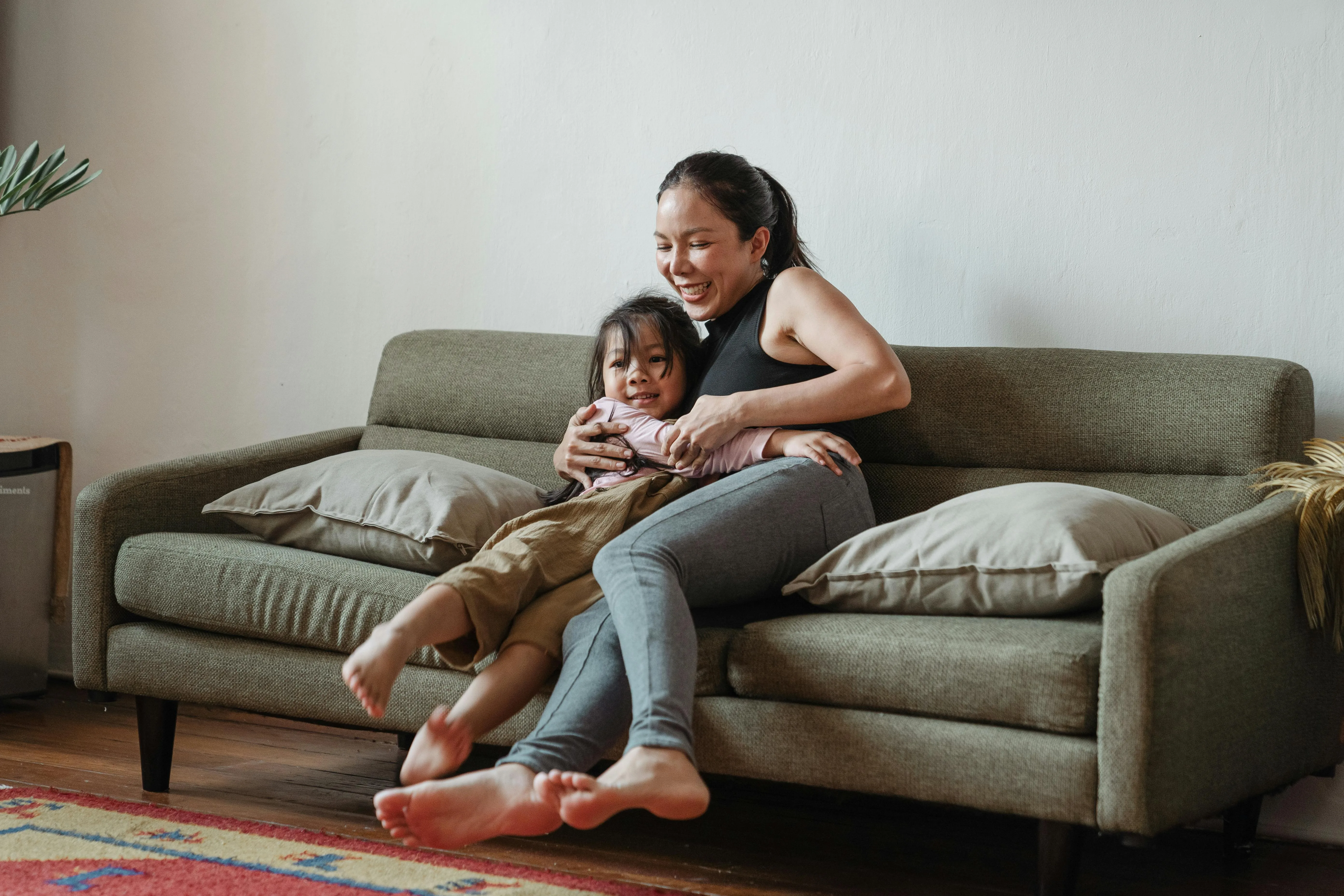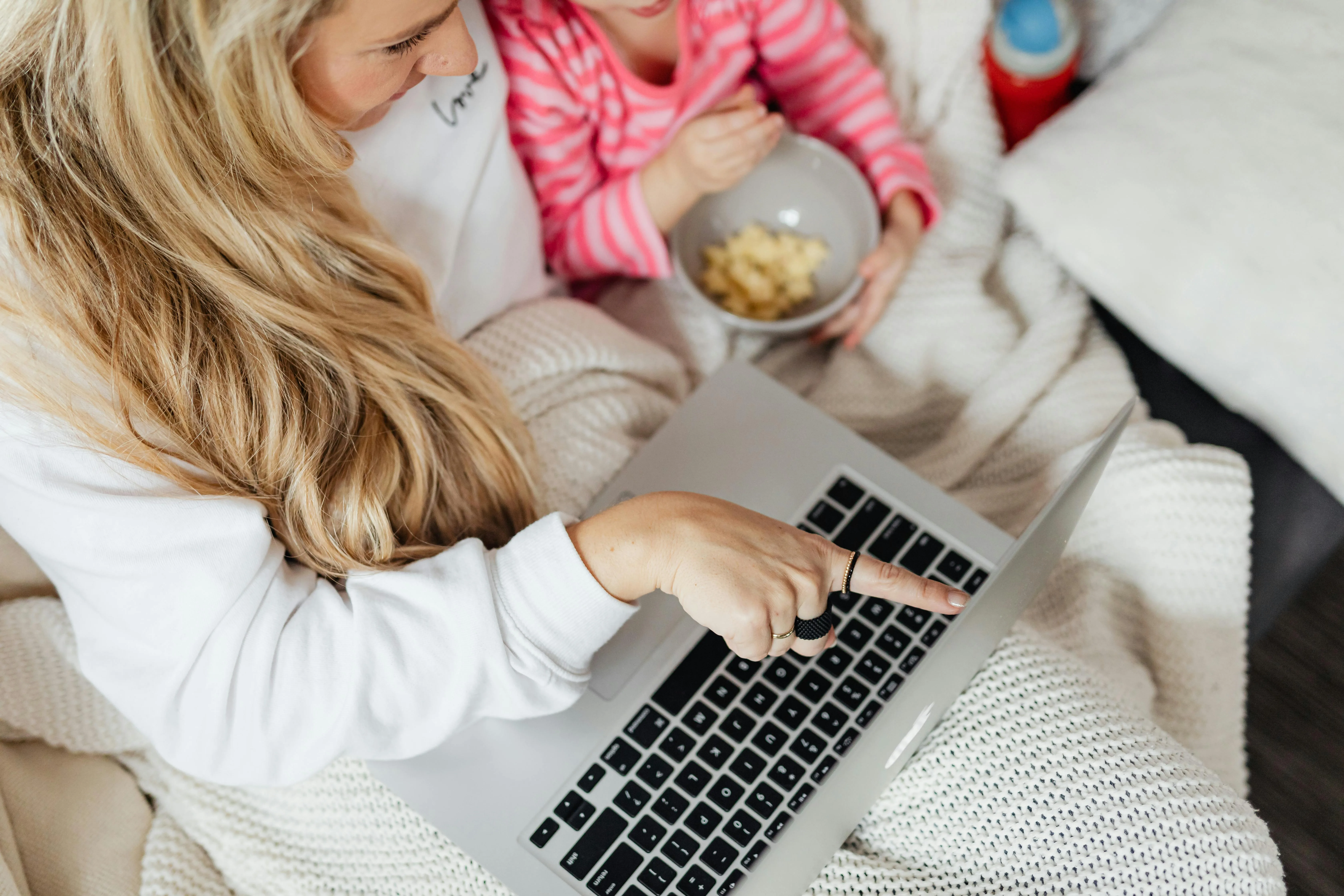When it comes to options for entertaining your toddler, things have probably changed a lot since you were a kid. Shows are brighter, louder, and more complex. Plus, between smartphones, tablets, and laptops, screens are just about everywhere.
The truth is, you don’t have to take a no-screen approach to entertaining your little one. The American Academy of Child & Adolescent Psychology says that screen time is okay starting at 18 months (with a caregiver). The important thing is that you’re intentional about the shows you choose for your munchkin. Today, parents are learning the value of low-stimulation shows for toddlers. These programs, characterized by low-impact visuals, minimal sounds, and slow pacing, offer a number of benefits. In this blog, we’ll go over why these soothing shows are gaining popularity and provide a list of our favorites.
What Are Low-Stimulation Shows?
Many popular kids’ shows today are over-stimulating, with jarring noises and surprising effects. Studies have found that these brighter, louder shows can harm a child’s self-control and ability to focus. A low-stimulation show, on the other hand, is designed to keep your little one calm and encourage focus. It will contain subtle visual effects, colors, and sounds, as well as a simple storyline. Here’s a closer look at the characteristics of low stimulation shows for babies and toddlers:
Slow-paced Storytelling
Developing minds need extra time to process information. Low-stimulation shows intentionally have slow-paced storytelling, allowing children to take in what they’re seeing. The plots are simple, and transitions are gentle, allowing young viewers to easily follow along. Slow-paced storytelling also prevents kids from being overwhelmed by abrupt changes.
Gentle Colors and Sounds
Colors influence the way everyone feels — adults and toddlers alike. But little ones don’t yet know how to process some of the stronger feelings that arise in the presence of bright, bold colors. Gentle colors, like pastels; muted colors like light green and yellow, and neutral/warm colors such as beige and light brown, promote a feeling of calm.
Loud or abrupt sounds can give a jolt to a toddler’s nervous system, too. So low-stimulation shows feature gentle sounds that won’t evoke a stress response in young viewers.
Minimal Fast Cuts or Overstimulating Effects
In addition to a story that doesn’t progress too quickly, low-stimulation shows feature minimal visual effects. They won’t contain many (or any) fast cuts or overstimulating effects like flashing lights, swirling shapes, or dancing letters. In general, settings won’t be overly busy, having a limited number of objects and/or characters on the screen at one time.
Educational and/or Emotionally Supportive Themes
Your toddler’s shows can provide a great opportunity to learn about important emotional concepts and life experiences. For example, your sweet pea can learn about empathy by watching characters being kind to a friend who is struggling. They might learn about sharing and teamwork by seeing characters be generous with each other or work towards a common goal. Watching cartoons about best friends or families can emphasize the importance of connection and demonstrate social skills.
How Low-Stimulation Shows Benefit Toddlers
Low-stimulation shows aren’t just a terrific alternative to high-stimulation content. These gentle programs can also support your little one’s development and promote a sense of well-being. Here are the benefits of low-stimulation shows for toddlers.
- Encourages focus and attention: The minimalist visual effects of low-stimulation shows prevent children from feeling overwhelmed or distracted. Remember, developing minds can’t focus on more than one or two things at the same time. Additionally, the predictable storylines help them feel secure, making it easy for them to follow the narrative. Each of these elements helps children build their attention span.
- Reduces sensory overload: Sensory overload never ends well with little ones. Any parent knows this intuitively. A child who was happy and giggling in the quiet car suddenly throws a tantrum in the busy mall. That’s because loud noises, bright lights, and chaotic environments trigger your tot’s stress response. And children don’t know what to do when they’re stressed other than have a meltdown. Putting a low-stimulation show on for them in busy environments can help soothe them and prevent tantrums.
- Aids in emotional regulation: Over-stimulating shows can spike children’s cortisol levels, and elevated cortisol levels can lead to behavioral issues. Meanwhile, low-stimulation shows can help prevent cortisol spikes, helping children feel more balanced, which can lead to improved emotional regulation.
- Language development: Without loud noises and dizzying visual effects to distract them, toddlers can fully focus on the storyline of their shows. Paying attention to the narrative will naturally help them learn new words, supporting their language development. Alternatively, over-stimulating shows can have so much going on that little ones can’t focus on the conversations happening on the screen.
- Better sleep patterns: Low-stimulation shows can be a part of a healthy bedtime routine. They can help create a calming environment that encourages winding down. The rhythmic, gentle sounds and calming colors of these shows can create the ideal conditions for a good night’s sleep.
How You and Your Au Pair Can Evaluate Shows for Toddlers
Monitoring your child and how they respond to shows is going to be an important part of building a healthy TV routine. If you’ve welcomed an Au Pair into your home, they can play a valuable role in implementing new screen time rules. An Au Pair can step in and watch shows with your little one when you are unavailable, reporting what they observe. Here are some behaviors that could indicate your child’s current show is too stimulating:
- Tantrums/fussiness
- Difficulty sleeping
- Decreased attention span
- Aggressive outbursts
- Increased worries/anxiety
If you or your Au Pair notice these patterns either immediately after your toddler watches shows, or in general, you might need to switch them to a lower-stimulation show.
Enlisting Your Au Pair in Choosing the Right Shows for Your Toddler
Getting on the same page with your Au Pair about appropriate shows for your toddler will help ensure your screentime strategy goes smoothly. Here are some things to consider when approaching this conversation:
- Share expert recommendations: Learn the correct amount of screen time and type of shows for your toddler’s age group, and share this with your Au Pair.
- Discuss parenting values: Express your parenting values to your Au Pair. If they have a solid understanding of the values you hope to instill in your children, this can help them decide which shows are correct for your little ones.
- Be clear about guidelines/limits: Make sure your Au Pair has clarity on screentime guidelines. These can include things like where your toddler can watch shows (in the car? In bed?) and with whom (alone? With friends?)
- Check in regularly: Touch base with your Au Pair at the end of each day about screen time, going over what your child watched, how they responded, and how your Au Pair feels their development is going.
Together, you and your Au Pair can work to understand how your toddler’s shows are affecting them.
8 Low-Stimulation Shows for Toddlers
One of the easiest ways to set your Au Pair up for success is to provide them with a list of approved low-stimulation shows for toddlers. Not sure where to start? Below, you’ll find our list of kid-friendly, soothing shows.
1. Bluey
What it’s about: Bluey features a lovable six-year-old Australian Blue Heeler puppy named Bluey and her family—her dad, Bandit; her mom, Chilli; and her little sister, Bingo. The show focuses on imaginative play, family bonding, and life lessons in a heartwarming and humorous way.
Why it’s great: Calm but engaging storytelling promotes family bonding.
Themes: Emotional intelligence, creativity, problem-solving.
Where to watch. Disney+, DisneyJunior, and YouTube
2. Sarah & Duck
What it’s about: Sarah & Duck follows the adventures of seven-year-old Sarah and her best friend Duck, who is, in fact, a duck. Each episode teaches a lesson about friendship and problem-solving, encouraging creative thinking.
Why it’s great: With a small character cast, the stories are easy to follow, and the lessons are emotionally encouraging.
Themes. Friendship, problem-solving, creative thinking
Where to watch. Amazon Prime, Apple TV, YouTube, and Peacock.
3. Puffin Rock
What it’s about: Puffin Rock takes place on a serene island off the coast of Ireland, so the visuals are nature-centric and soothing. The show follows two puffins, brothers Oona and Baba, as they explore their surroundings.
Why it’s great: The setting is calming, while the episodes encourage family bonds.
Themes. Problem-solving and the importance of family.
Where to watch. Netflix, Amazon Prime, YouTube, AppleTV
4. Little Bear
What it’s about: Little Bear follows the adventures of its namesake character, Little Bear, as he explores the forest with friends and family. Recurring characters include his friends Duck, Hen, Owl, Emily, and Cat, as well as his parents, Mother and Father Bear.
Why it’s great: The show’s muted colors, like light green and brown, are soothing, and the plots are simple.
Themes. Empathy, friendship, and creativity.
Where to watch. Paramount+, Amazon Prime, YouTube, Apple TV
5. Franklin and Friends
What it’s about: Franklin and Friends follows six-year-old turtle Franklin and his animal buddies, including Fox, Beaver, Rabbit, Goose, and others, as they explore and solve mild mysteries.
Why it’s great: The show helps with language development, as little ones learn the many animal names. Plus, it encourages curiosity and exploration.
Themes. Friendship, problem-solving, adventure.
Where to watch. Amazon Prime
6. Kipper the Dog
What it’s about: Based on the popular picture book series, Kipper the Dog follows Kipper, a friendly and fun dog, on his adventures in the English countryside. He’s often joined by his friends like Tiger, Pig, and Arnold, who each have distinct flaws like impatience and irritability, which allow for important teaching moments.
Why it’s great: The setting features soothing nature imagery, and the characters facilitate gentle introductions to common dilemmas.
Themes. Teamwork, patience, curiosity, friendship.
Where to watch. Amazon Prime
7. Miss Rachel
What it’s about: Miss Rachel is an educational show that features fun, interactive lessons on core subjects like letters, colors, and shapes. Each lesson is taught by the eponymous Miss Rachel, a friendly TV personality with a sweet, encouraging voice.
Why it’s great: Miss Rachel speaks slowly so children can process new information and provides plenty of encouragement.
Themes. Common preschool concepts are paired with songs and games for easy learning.
Where to watch. Netflix
8. Trash Truck
What it’s about: Trash Truck is about six-year-old Hank and his best friend, a garbage truck named Track Truck. The show follows the two as they get into all sorts of antics designed to introduce a life lesson.
Why it’s great: The show’s silly humor will keep children engaged so they can process the life lessons.
Themes. Sharing, friendship, curiosity, creativity.
Where to watch. Netflix
Tips for Host Families and Au Pairs When Watching Shows with Toddlers
Screen time doesn’t simply have to be a distraction or a way to calm a fussy child down. It can cultivate conversations and inspire activity away from devices! Here are ways you and your Au Pair can make the most out of watching shows with your little one.
- Make screen time interactive: When a major lesson is revealed, you can pause the show and ask the toddler what they learned in the episode. Or, you can ask more open-ended questions, like who their favorite character is or what they like about the show. It’s a way to understand your child’s developing mind better.
- Use shows as a springboard for real-life learning: See if your tot’s shows can inspire real-life activities. Programs that take place in nature might motivate your little one to go on a walk with you. Cooking-centric shows might get them excited about spending time in the kitchen with you, where you can give them a small job.
- Set screen time limits and incorporate other calming activities: Set screen time limits and stick to them. If shows are meant to help soothe your kiddo, make sure you have another calming, non-screen activity you can easily transition to when you turn off the device.
- Encourage storytelling and role-play based on characters: Keep the storytelling going together with your munchkin! You can pretend to be some of the characters from the shows, sparking your little one’s imagination.
If your Au Pair spends a lot of time with your sweetie pie, you can always ask them if they have any ideas for optimizing screen time. Keeping an open dialogue fosters a supportive environment, where everyone feels equally invested in the well-being of your toddler.
Get Matched with Au Pairs Who Share Your Child-Rearing Values
In today’s chaotic world, children get enough stimulation. So when you put a screen in front of them, show them content that can soothe them. Low-stimulation shows can help children feel calm and secure while promoting focus and creativity. They’re the perfect way to ease an anxious child or simply create a calming bedtime routine.
Learn how Go Au Pair matches families with Au Pairs who share similar philosophies and values when it comes to caring for your child, including screen time. Contact Go Au Pair to get started now!






